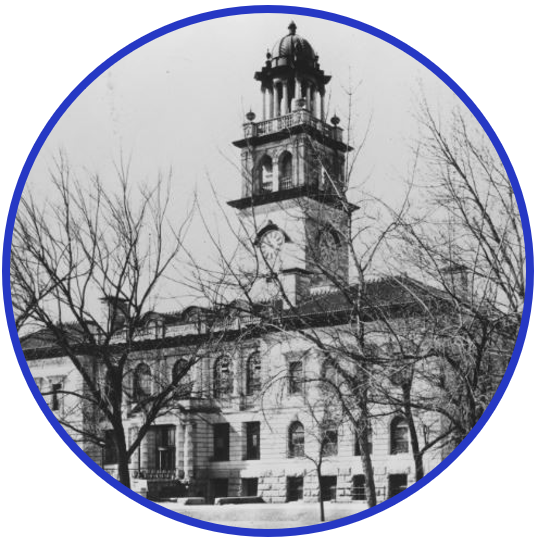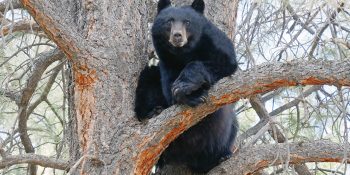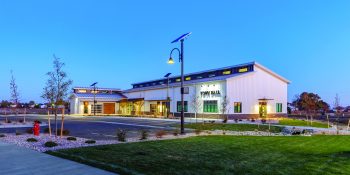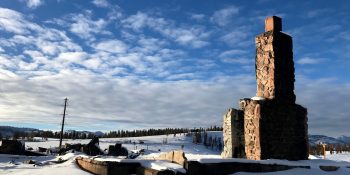By Michael Elizabeth Sakas, CPR News
When the East Troublesome fire hurtled towards Matthew Reed-Tolonen’s Grand Lake home last October, he made sure to lock up his family’s fireproof safes before they evacuated.
“That was like the marriage license, birth certificates, all that kind of stuff,” Reed-Tolonen said. “I thought I was good. I was like, ‘All right, it’s closed.’ And this is an expensive safe, we’re good. It didn’t do anything, just ash.”
Hundreds of Colorado homeowners now face the tough choice of whether or not to rebuild after last year’s historic wildfires ripped through mountain communities like Grand Lake. For Reed-Tolonen, rebuilding was never a question. He and his wife grew up in the area, and they got engaged on the empty lot where their mountain home would eventually be.
“I’m kind of bummed out that it’s a question for so many people,” Reed-Tolonen said. “I get people are nervous because they had their dream home for so many years and it’s gone. But maybe that’s why it’s so much easier for us. We just got into ours.”
Their home stood for less than a year.
To better prepare their new home for a future disaster, as climate change fuels more fires that are bigger and more destructive, Reed-Tolonen said he’ll likely keep trees further away from the structure. He’ll also rebuild with metal wainscoting four-feet up on the house’s exterior.
“Other than that, it’s going to be wood siding again,” he said.
There are other siding materials that are more resistant to wildfire like brick, stucco and cement-fiber.
But unlike in California, there are no statewide laws in Colorado that require people like Reed-Tolonen to build with certain materials or mandate how they manage their land.
Thoughtful changes to both can greatly increase the chances of a home surviving a wildfire, according to the National Fire Protection Association.
“There are many layers of difficulty with doing something like that,” said Lisa Dale, a lecturer at Columbia University in the sustainable development program.
A task force learned that in a local-control state, it’s hard to pass statewide laws — even when they would save homes.
Dale was part of a 2013 Colorado task force that looked at the best ways to protect people and property after one of the state’s most destructive wildfire seasons ever. The previous year, six people were killed, more than 640 structures were destroyed and more than 30,000 people were forced to evacuate.
The group’s final report suggested the state create a model ordinance for homes built in areas at risk for wildfire. That mandate could include building codes since the use of fire-resistant building material has been found to be one of the most effective measures at preventing a home from burning down. It could also establish defensible space requirements, which would specify how the area around a home is landscaped and maintained.
California has laws for both. The state adopted a mandatory building code for new homes built in wildfire-prone areas in 2008, and recent fires suggest that the change is likely keeping homes from burning down.
The Colorado task force recommended that either the wildfire code be mandated for areas at risk for wildfire by the state or that the model ordinance would be something local governments could adopt.
“We had people in the group from the insurance industry, from the building industry, from conservation groups. And we really thought, well if we can come to some agreement within the group, then surely that agreement will also be reflected out there in the real world,” Dale said.
Eight years and numerous disastrous wildfires later, no model ordinance exists. The effort died at the State Capitol. Dale said she’s not surprised.
“Those elected officials were also being contacted by lobbyists, who represented some of those industries that were really concerned about these recommendations,” Dale said. “Legislators would have had to sort of override some of those pieces of feedback that they were getting from their constituents.”
A 2014 committee tasked with proposing wildfire legislation rejected a bill that would have mandated a building code for areas threatened by wildfire.
Democratic State Rep. Tony Exum Sr. of Colorado Springs was part of the group. He said they did get pushback from industry representatives on points like construction costs to homeowners and developers, who wanted to see those decisions kept to a local level.
“We’re a local-control state,” Exum said. “It’s tough for us to create laws that override the local control in those areas.”
A 2020 report from NPR showed that home builders groups felt that local governments should determine their own codes and rely on educating homeowners about wildfire preparation through outreach.
“I think we question the efficacy of a statewide [wildland-urban interface] code, because we support local codes,” Ted Leighty, CEO of the Colorado Association of Home Builders, told NPR. “We believed, and still do, that codes are best developed, implemented and enforced by local governments. Each local area has unique issues and circumstances and geography.”
What can a town or city do if homeowners want to take the risk and keep the trees in their yard?
Some places, like Boulder and Colorado Springs, have adopted laws on how new homes should be built in wildfire areas. In 2009 the Breckenridge town council tried to address fire hazards to existing properties with an ordinance that required residents to create a defensible space around their home. That meant cutting down some trees.
Breckenridge Mayor Pro Tem and town council member Jeffery Bergeron remembers the heated community meetings. Residents were worried about “draconian government overreach,” and they didn’t want to cut down their “prized bristlecone pines,” Bergeron said.
“It was like going to a knife fight with a Q-tip,” Bergeron said.
Bergeron said the backlash is a prime example of why the state should take the lead on wildfire mitigation laws. Breckenridge residents were angry. Erick Buck, a local real estate broker, started a petition that collected enough signatures to force the town to kill the ordinance.
“If the local people decide that that’s not the way they want to address the issue, then you know, that really is up to them,” Buck said.
After his petition killed the mandate, Buck sat on a committee to help the town figure out how to encourage residents to voluntarily clear fire hazards around their property. Eventually, Buck cut down trees on his property and encouraged his neighborhood group to do the same.
Buck said his community’s voluntary efforts show that codes and mandates aren’t the right way to address wildfire mitigation on private property.
“If my home is going to burn down and I’m willing to take that risk because I want to have trees in my yard, that’s really up to the individual owner to make that decision, not the town to tell them,” Buck said.
In Grand County, where Matthew Reed-Tolonen is rebuilding his home, county commissioner Richard Cimino said they would appreciate it if the state came out with a model wildfire code. But even if that happened, Cimino said the county would promote its guidance as voluntary and likely wouldn’t make any of it mandatory.
SPREAD THE NEWS
COMMENT, Like, Follow & SHARE @I70Scout











